
|
      
|
 |
Glengoyne Distillery
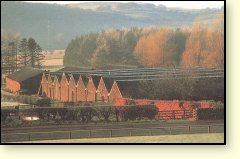
 |
|
Location: Dumgoyne, nr. Killearn, Stirlingshire G63 9LB
Roads: On A81, 500 metres south of junction with A875
Hours: Easter - November, tours on the hour 10am - 4pm, Mon - Sun and Tues / Thurs evenings; December - March, Mon-Fri 10am-4pm.
Telephone for information about evening tutored tasting - Group bookings, max 50; larger parties by appointment
Reception centre, heritage room and shop. Video and booklets in French, German, Italian, Spanish and Japanese
Phone: 01360-550254
Fax: 01364-550094
Homepage: www.glengoynedistillery.co.uk
|
Snug at the bottom of a mare’s-tail burn that falls down the side of Dumgoyne Hill, Glengoyne is a pretty, endearing distillery that just begs to be visited. Behind the main buildings is a secret little glen where the final 60-foot (18m) of the burn splashes into a pool. Visitors sip their dram overlooking it all after their tour round the distillery. Loch Lomond lies to the north-west and 15th-century Duntreath Castle with its mediaeval stocks and dungeons is just down the road.
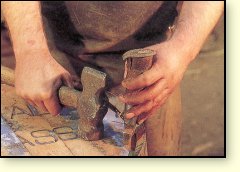
A cooper at work, sealing the gap between the cask head and the staves.
|
Every distillery had its live-in Excise Officer until very recently. The Officer at Glengoyne at the tail-end of last century was Arthur Tedder who later gave important evidence at the 1908 Royal Commission which decided whether grain spirit qualified as whisky. He became the Chief Inspector of Excise and was later knighted; his son, who had grown up at Glengoyne, was made Air Chief Marshal of the Royal Air Force after a brilliant war record as deputy supreme commander under Eisenhower. When made a baron he chose the title of Baron Tedder of Glenguin, the old spelling of Glengoyne.
The distillery emerged directly from the illicit distilling activity that covered the floor of Strathblane and the Small Stills permitted by law and mostly held by the landowners in the district. The first Glengoyne distillery in 1833 belonged to the Edmonstones of Duntreath Castle and probably displaced a Small Still on the same site. The distillery came into the hands of Lang Brothers, the present owners, in 1872. Glengoyne is a Highland malt.
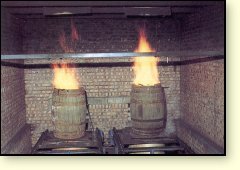
Fire is used to toast the casks before the new spirit is added.
|
There are three stills, one of which is getting on for 30 years old (on average stills last about 20 years). The other two are six years old. This does not mean triple-distillation, although it used to be carried out at Glengoyne. Now the two spirit stills have been made of a size that enables them together to take a single batch of distillate from the wash still. The rapidity or otherwise of distillation is an important factor in the quality of spirit – the slower the better; Glengoyne’s distillation rate is said to be very slow.
The lack of space at Glengoyne meant its going over to buying in malt as early as 1910; it also meant that the filling store had to be across the road from the distillery. Rather than have the men dodging traffic as they trundled casks across the busy road, a copper pipe was installed under the roadway and the whisky is pumped direct from the distillery to the filling store.
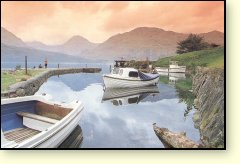
As the mountains close in around the top of Loch Lomond, the pier at Inversnaid provides a delightful viewpoint.
|
Before a rebuilding programme in 1966, Glengoyne was one of the smallest distilleries in Scotland. Today it is still small and attracts a lot of visitors. The distillery has its own helipad and as many as six helicopters a day land unloading customers, agents and even tourists on tight schedules.
The Whisky
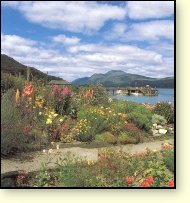
Luss is a scenic village, with its own pier where you can take a steamer up the Loch.
|
Glengoyne is light, soft and approachable in style. It has a fine, forward maltiness with fruit-and-nut finish. The attractive medium-depth complexity of Glengoyne comes through at least partly because there is no peat reek whatsoever in the whisky. The malt is dried without peat smoke, leaving the herby, botanical notes unmasked. The plain-oak maturation also helps this, although a proportion of the whisky does come from sherrywood. There are 10, 12 and 17-year-old editions and the occasional ‘one-off’ like the recent Christmas Day, 1967 issue which was distilled on Christmas morning of that year. Independent bottlings are rare.
Source of water
Waterfall from Campsie Hills
Of interest
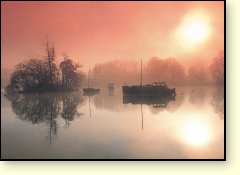
Legendary scene with a wintery mist and the sun set low in the sky it is easy to see how mysterious legends grew up.
|
• Luss, on the west bank of Loch Lomond, is very beautiful. Wednesday to Friday you might catch them filming the Take the High Road TV serial, but the walking and sailing are excellent too. One of the delightful islands in the loch hosts a naturist club and pleasure boats passing the spot are said to list to one side as passengers crowd the landward rail for a glimpse of movement onshore.
• Inversnaid is the old steamer terminal on the east bank of Loch Lomond where it begins to narrow. The road stops there so it is tranquil and relaxing.
|
|  |
 |
|